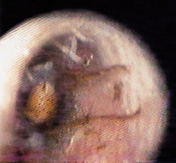
Am Fam Physician. 2000;61(9):2606-2611
to the editor: Spring is the best season in Tokyo, with cherry trees blossoming beautifully after the winter rest. However, many uninvited guests are also awakening from their sleep.
This spring, a 40-year-old man was admitted to our clinic with a sudden onset of tinnitus and severe pain in the left ear. The tinnitus and pain occurred simultaneously while the patient was sleeping. On examination, we found a bug stuck in the external auditory canal (see the accompanying figure). The bug seemed to be struggling to reach the patient's eardrum. We applied a topical anesthetic (4 percent lidocaine), which had a desirable effect on the patient and the bug.1–4 It was immobilized and easily removed with forceps.

The bug was a cockroach. We had seen some reports like this one.1–5 For anatomic reasons, a cockroach is generally unable to back out of the external auditory canal. The more it tries to back out, the more stuck it becomes. In this case, the use of a topical anesthetic decreased the patient's symptoms and also removed the bug's confusion.
After removal of the bug, the patient's symptoms disappeared completely. We informed him that a “pretty insect” had been stuck in his ear. To prevent adverse psychologic reaction, we did not tell him it was a cockroach. The patient is now able to sleep comfortably. What about the cockroach? It is also sleeping, in formalin.